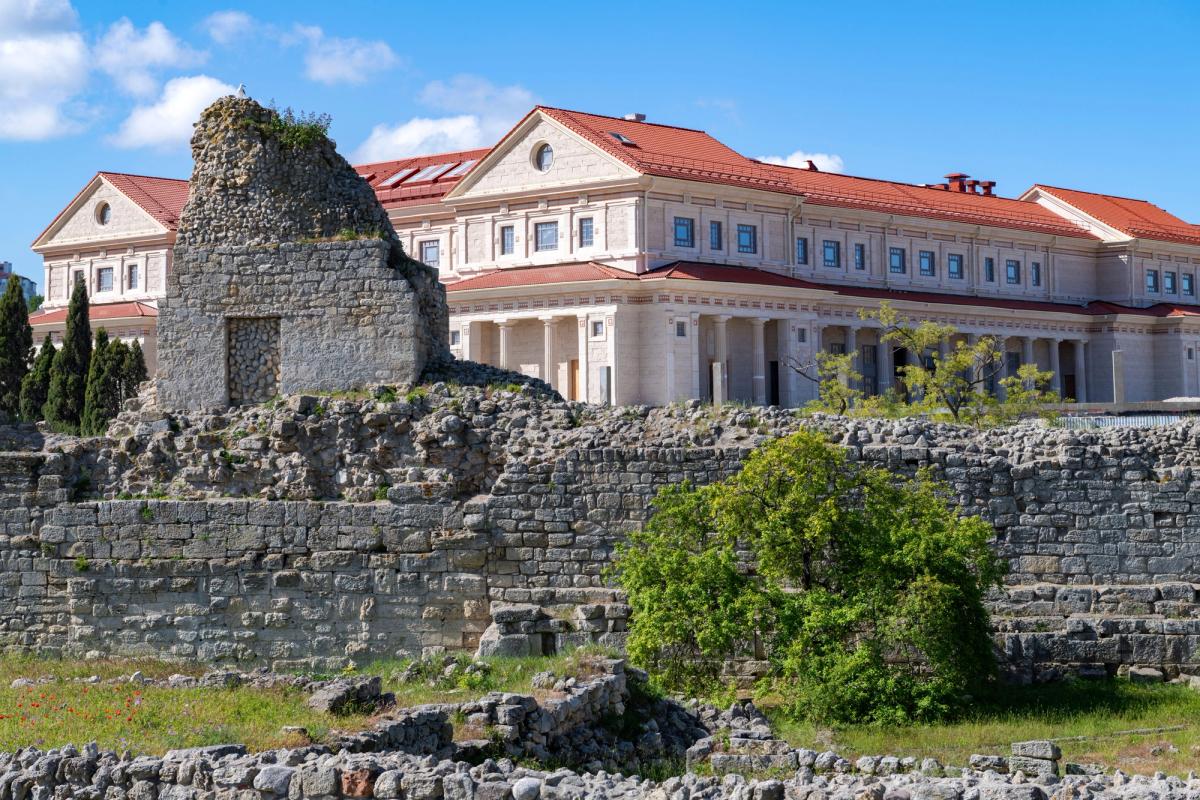Ukraine has appealed to the United Nations (UN) to protect Tauric Chersonese in Crimea, a Unesco World Heritage Site, after Russia completed work transforming it into a “historical and archaeological park”.
The site, an ancient city founded by Greek colonists in the fifth century BC, was inscribed on Unesco’s list in 2013—less than a year before Russia illegally annexed the Black Sea peninsula from Ukraine. The new complex, located in what was a suburb of the old city, features a Russian Orthodox monastery as well as several museums. These include a Museum of Christianity and the Museum of Crimea and Novorossiya, which is the term that Russia uses for the territories it illegally annexed from Ukraine.
Vladimir Putin has visited Tauric Cheronese in the past and spoken of it and Crimea more widely as central to Russian statehood, adding to feeling that the decision to reimagine it is an elaborate propaganda exercise.
The new complex, which was constructed by Russia’s ministry of defence and funded by Transneft, a state corporation, was officially opened on 28 July. It has been named “New Chersonese”. Putin has charged Metropolitan Tikhon Shevkunov, a senior cleric who has promoted Chersonese as the heir of Byzantium, to oversee the project and the new monastery.
Ukrainian experts say Chersonese is not recognisable as the archeological landmark they once studied. On 24 July, Dmytro Lubinets, the Ukrainian parliament commissioner for human rights, appealed to the UN to intervene, saying that the damage to Tauric Chersonese was part of a Russian policy to erase Ukrainian cultural heritage.
In the statement, which he posted on his Telegram channel, Lubinets said that “the Russians have completely destroyed the authentic monument”, adding that they are “actually building a new city—the so-called historical and archaeological park”. Lubinets says that “many archaeological finds“ had also been “stolen by the Russian Federation and taken to Russian museums.”
In a recently published report, Evelina Kravchenko of the Institute of Archaeology of Ukrainian National Academy of Sciences, outlined the damage to the site, while also referring to the removal and potential loss of artefacts.
“The construction works destroyed the cultural layer, which in some places reached more than 10 metres, the remains of an ancient temple, the city necropolis with unique burial and memorial structures, layers of ash and litter, the remains of suburban complexes of the WHS together,” Kravchenko wrote.
“In addition to the fact that the general appearance of the site was disturbed, which led to the distortion of the ancient landscape, tens of thousands of finds excavated by soil works from destroyed suburban complexes were removed from Crimea, other tens of thousands ended up in the modern landfills of Sevastopol [a large Crimean city], where they were taken by dump trucks from the construction zone,” she said, adding: “Some of them were picked up from these dumps by local people both for personal storage and for sale on the black market. Thus, soon we will be able to see things from Chersonesos on online auctions.”
Yevheniya Kravchuk, a Ukrainian MP who is chair of the Committee on Culture, Science, Education, and Media of the Parliamentary Assembly of the Council of Europe (PACE), spoke to The Art Newspaper about Russia’s motives. “Crimea is for them very important, both because it contains the oldest sites, the oldest cities on the territory of Ukraine,” she says. At New Chersonese, she continues, “the strategy from Russia was to excavate all the old foundations, throw them away, and build something conveying the idea that they build better than the ancient Greeks.”
Kravchuk was the author of a resolution passed in June by the Parliamentary Assembly of the Council of Europe accusing Russia of “erasure of cultural identity” in Ukraine.
The New Chersonese project follows other work at Tauric Cheronese including the renovation of St Vladimir's Cathedral, believed to be on the spot where Prince Volodymyr of Kyiv was baptised into Orthodoxy in 988, and the construction of an open-air theatre on the remains of a Roman citadel.
At the 46th Session of the World Heritage Committee in New Delhi, India last month, Anastasiya Bondar, the head of the Ukrainian delegation, deputy minister of culture and information policy of Ukraine, began negotiations about including Tauric Chersonese on Unesco’s list of World Heritage in Danger, the ministry reported on 1 August.
Speaking to The Art Newspaper in August, a spokesperson for Unesco said that based on information it had gathered, “developments in the World Heritage property ‘Ancient City of Tauric Chersonese and its Chora’ and its buffer zone are of particular concern,” for the organisation. It listed the ampitheatre that “appears to have been built in the core area of the property’s Chersonese Ancient City component” as one of several concerns. It also noted that “the construction of an extensive archaeological park appears almost complete, involving heavy machinery, increased soil movement and greater impact on the archaeological layers.”
The spokesperson said, however, that “given the temporary occupation of the territory, the competent authorities of Ukraine are not able to provide access to the historical sites,” and so a Unesco team has not been able to assess them on the ground. Regarding a decision to inscribe the property on the list of World Heritage in Danger, they said that “only the World Heritage Committee, made up of 21 states parties to UNESCO World Heritage Convention, is able to take such a decision.”
On 1 August, Putin’s spokesman Dmitry Peskov said: “If they wish, Unesco representatives will be able to come to Crimea, to Tauric Chersonese, and admire what it has become."


